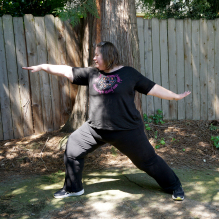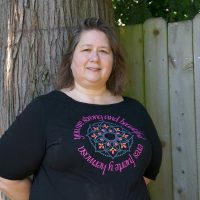View this post on Instagram
When I tell people I teach yoga, I generally get one of two reactions: “Wow, that’s great!” or “You are?!?!?”
I’ll be honest: the reason they are surprised is because I’m a larger person. Plus-size. Zaftig. Whatever euphemism you want to use.
That’s right, I’m a fat, middle-aged person who teaches yoga.
The “Wow, that’s great!” group is generally a tad surprised, but think it’s cool. If the person is not into “traditional” yoga, they may ask questions, tell me about how they have been afraid to try yoga, or why they think they are not bendy enough. They may tell me that it’s hard for them to get on the floor, or they don’t want to be the largest person in class, or they feel like they won’t be welcomed as a person who is (insert a marginalized identity here).
The “You are?!?!?” group look me up and down dismissively and either act speculative like they think I’m playing some kind of joke on them, or move on without a comment, dismissing me. They dismiss me because in their world, it does not compute that a middle-aged fat woman teaches yoga.
I, of course, teach for the first group—those are my people.
I first came to yoga years ago to help manage pain, but even when I was younger and much fitter than I am today, I struggled to feel accepted in the yoga world. I was always the largest person in class and teachers either completely ignored me or seemed confused by what to do with me.
One time, a teacher was trying to force me into a pose, and I said, “I can’t do that, my stomach is in the way.” Their response was a frustrated, “I don’t know what to tell you then.” I asked, “What do you tell a pregnant woman when her stomach is in the way?” and she suddenly had several suggestions. Skinny people got pregnant and came to class, so teachers knew how to help them. Fat people, people whose bodies were different for other reasons, that was a mystery.
It took a long time to find a yoga studio that was created for people like me—nontypical yogis. A place where larger, older, gender nonconforming people, people with disabilities, and everyone in between was welcomed. A place where every class included “options” for different bodies instead of “modifications” for people who couldn’t do yoga the “right” way.
After several years attending classes at this studio, I decided to join their new Yoga Teacher Training (YTT) program. I started my YTT with one purpose: to deepen my own practice. I had absolutely no intention of ever teaching yoga.
But, something funny happened in YTT: they expected me to do practice teaching. You know, to demonstrate competency in what I was learning. I was terrified.
Me, the introvert, the person who never wants to the center of attention, the person who always hangs out in the back of the class when I go to the gym because I don’t want people to see me exercising—suddenly I’m in front of a class teaching yoga. People are watching me adapt a pose to move around my stomach. People are seeing where I’m saggy, where I have fat rolls, getting a close up visual of the size of my ass and…I don’t mind at all. I love it.
Honestly, it was a revelation. By the time I finished the teacher training, I actually wanted to be a yoga teacher. Life can be so weird.
And, it’s been awesome. I taught a class recently that included two older ladies, one had just had a hip replacement, the other had bad knees and couldn’t bend well. And because of my training in adaptable yoga, I was able to teach poses that worked for them, with options that worked for the other students in the class.
That’s how I teach every time. I start at the baseline poses and add on from there. If I teach a balance pose, I always start by the wall. Then it’s there if you need it, but if you don’t, it’s cool. If I’m doing a standing pose, I start with the legs, then offer various arm options to add on.
The other day I was teaching a class that is specifically for those who are curvy. As we leaned forward toward the floor in a forward fold, I demonstrated how, when I do it, I grab some of the fat on my stomach and move it out of the way to get deeper into the pose. I talked about how sometimes I’ll use my pant legs to help me move my leg close enough to grab it. I also talked about how with my center of balance, I prefer to step forward into a lunge instead of back.
When I teach, I tell people there’s no “right” or “wrong” way to do yoga. Instead, I focus on what the purpose of a pose is: to lengthen the spine, to stretch the hips, to strengthen, to twist, and so on. And if one pose doesn’t get that person there for whatever reason, I offer an alternative. It’s about the benefit of the movement, not about a specific way to look doing it.
When I look around and every single person doing the pose looks a little bit different, it makes me happy because I know that people are meeting themselves where they are right now. Being kind to their bodies. Listening to their bodies. Focusing on the heart of the pose, instead of the look of the pose.
It makes me happy because I know that everyone there is doing yoga.
We all see the Instagram and Pinterest versions of yoga: skinny, young, cisgendered white women twisting themselves into pretzel-like shapes.
But yoga is more than that. Much more. Yoga is about going within. Yoga is about accepting your body and moving in harmony with it. Yoga is about connection. Yoga is about having some fun in a pose, even if you need to move a fat roll out of your way to do it.
When people give me the dismissive “You are?!?!?” when I say I’m a yoga teacher, I ignore them. Those people have lots of yoga teachers they can work with.
I teach yoga for the rest of us. And that makes me happy.












Read 29 comments and reply